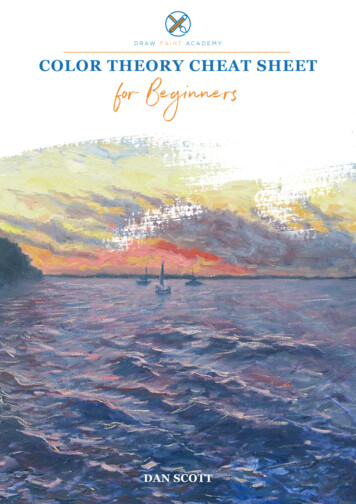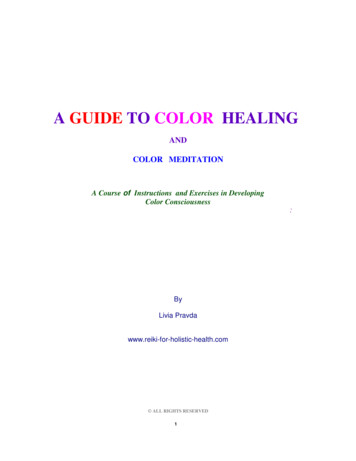
Transcription
COLOR THEORY CHEAT SHEETfor BeginnersDAN SCOTT
IntroductionThanks for downloading this cheat sheet. The purpose of this sheet is to give you abrief overview of color theory as it relates to us as artists.Color is amazing. It is all around us. It influences our decisions, evokes feelings andadds vibrancy to our beautiful world. But, because color is so involved with our dayto-day lives, we tend to overlook its importance.I hope this cheat sheet gives you a better understanding and appreciation of color. Ifyou have any questions, feel free to email me at dan@drawpaintacademy.com.Happy painting!Dan ScottDrawpaintacademy.com2
The Three Elements OfColorColor is much easier to understand when you break it down into separate elements,which are:Value: How light or dark something is, with white being the highest value and blackbeing the darkest value.Monet, The Red HouseSaturation:A measure of how intense, rich or vivid a color is. Most colors are intheir most saturated forms straight from a tube, then they lose saturation as you mixthem with other colors.Hue:Refers to the position of a color on the color wheel. Red, blue, orange, green,yellow - these are all different hues.3
Other Color TheoryTermsTINT: A color plus white.SHADE: A color plus black.TONE: Used to broadly describe different mixtures of a color. You will also hear artists use the phrase “toned down” to describe reducing the saturation of a color (making it closer to gray).VIVIDNESS, CHROMA, RICHNESS, PURITY: Refers to the saturation of a color.HIGH-KEY: Refers to a range of light colors (colors in a high-value range).LOW-KEY: Refers to a range of dark colors (colors in a low-value range).Childe Hassam, Moonrise at Sunset, 1892TEMPERATURE: Refers to how warmor cool a color is in terms of color temperature (think orange versus blue).This is not a physical temperature, butrather an implied temperature.Childe Hassam, Nocturne, RailwayCrossing, Chicago, 18924
COLOR SCHEME: An arrangement of colors which is generally considered to be aesthetically pleasing. The popular color schemes used by artists are complementary,analogous, triadic, split-complementary, Monochromatic and rectangular.COMPLEMENTARYANALOGOUSTRIADICJohn Singer Sargent, Fisherwoman, 1913Claude Monet, Water Lilies andJapanese Bridge, 1897-1899Johannes Vermeer, The Milkmaid, TICClaude Monet, RegattaAt Argenteuil, 1872Vincent van Gogh,Sunflowers, 1888Claude Monet, MorningOn The Seine, 1897COLOR HARMONY: Refers to the relationship between colors.5
The Color Wheeland How to Use ItSince the origination of the color wheel by Isaac Newton, it has become one of the mostpowerful tools available to artists for explaining the relationships between colors.The color wheel is comprised of 3 primary colors, 3 secondary colors, and 6 tertiarycolors.The three primary colors are red, blue and yellow.The three secondary colors are green, orange and purple. These are made by mixingtwo of the primary colors.The six other colors on the color wheel are the tertiary colors.6
Color MixingBasicsYou can mix almost any color using just the primary colors (red, blue and yellow) andwhite. This is why painting with a limited palette is often recommended for beginners,as it forces you to learn how to mix your own colors rather than relying on pre-mixedcolors.Here are some tips for color mixing: Mixing any two primary colors will create the color between them on the colorwheel. For example, by mixing red and blue, you will get purple. You can reduce the saturation of a color by mixing it with the color on the oppositeside of the color wheel. These are complementary colors. For example, you canreduce the saturation of orange by mixing it with some blue. To darken a color, you can add blue, black or an earthy color such as raw umber orburnt sienna. To lighten a color, you can add yellow or white. To mix a natural black, you can combine a dark blue with raw umber or burnt sienna (you do not need to use black straight from the tube).7
The Three Mythsof ColorI want to address a number of common color myths that seem to be floating aroundthe art world.Color Myth #1That a color can be ugly, bland, or boring.A color is just a color. How we perceive a color is entirely subjective.You will often hear people referring to grays and browns as being “ugly” colors. Wetend to associate these colors with less glamorous aspects of life.But let me assure you that they are not ugly colors. They are just colors. How you perceive and interpret those colors is up to you.Eugène Delacroix once said, “I can paint you the skin of Venus with mud, providedyou let me surround it as I will.”If you look at many of the great paintings you are inspired by, you may notice thatgrays and browns are dominant colors. Without gray and brown, how could you showoff your vibrant reds, greens, yellows, and so on?So there are no ugly colors, just colors of different saturations, values, and hues.Now you may be wondering that if there are no ugly colors, there can also be no“beautiful” colors. And that is correct.You may hear me say from time to time that a color is beautiful. But I am usually referring to the way the color is used in the painting, rather than the color itself. A colorby itself has no meaning. It is what surrounds that color that gives it meaning.If you deem certain colors as being ugly or beautiful, you are really placing a limit onwhich colors you are willing to use in your paintings. Why would you want to limityourself in any way?So don’t think of a color by itself as being either ugly or beautiful. Instead, aim to makeyour colors appear beautiful as a whole in your painting, with each color playing animportant role in the overall harmony.8
Color Myth #2That you can apply predetermined color recipes or schemes to achieve color harmonyin all your paintings.Unfortunately, nature is not so predictable that you can apply some color scheme orrecipe and achieve great results every time in a painting.I think of color more as a beautiful dance between all the different hues, tints, shades,and tones, rather than something that can be simplified into a standard formula.Color is not simple, and it is not a perfect science in painting. But that is OK, and thatis part of the fun of painting.Instead of searching for simple formulas or schemes to help you apply color, learnhow to see color and how to manipulate it. For example, say you want to mix a translucent blue-green color for a crashing wave in the surf. Instead of searching on Googlefor “how to mix turquoise” or “how to paint the color of water,” ask yourself thesequestions: What color tree does the color belong to (red, blue, yellow, orange, green, or purple)? Is the color leaning toward another hue (is the blue of the water leaning towardgreen or purple)? What is the value of the color (how light or dark is it)? What is the saturation of the color (how dull or vivid is it)?If you can answer these questions, then you can mix the color! No source on the internet will be able to tell you without seeing what you see first.Color Myth #3That some people have the “gift of color.”The ability to see and use color is not some gift you are born with. It is not somethingthat you either have or you don’t.It may relieve you to know that color is something you can, in fact, learn and improve.But to do so, you need to think of color as a skill, rather than a character trait that youeither have or do not have.9
For some of you, this will be good news, as you will be able to go forward and improveyour understanding of color. However, those of you who believe you have the gift ofcolor may not like hearing all this, as it means you cannot just sit back and rely on yournatural gift, and you, too, must go out and improve your knowledge of color.Learning color is the same as anything in art.First, you need to understand the theory behind color. If you learn based on flawedtheories (and trust me, there are a lot of them floating around in the art world), thenyou are really crippling your painting skills. Learning color and painting should be aslow but steady improvement based on proven fundamentals.Second, you need to practice and make mistakes. Without mistakes, you will neverimprove.Thirdly, you need to analyze and learn from your mistakes. Mistakes are only good ifyou actually learn from them.I can help along the way, but it is up to you to practice.10
PsychologicalTriggersColor has a powerful influence over human behaviour, to the extent it can manipulateyour perception of what is actually there.Here are some colors and their psychological triggers:Passion, love,anger and dangerHealth, natureand wealthVitality, creativityand activityTrust, securityand spiritualityEnergy, lightand hopeCreativity, royaltyand wealthHowever, please note that these psychological triggers are all subjective and vary fromperson to person.How do these two paintings make you feel? Do you feel any different psychologicaltriggers from them?Claude Monet, Houses Of Parliament, Sunset, 1904Claude Monet, Water Lilies, 1897-189911
Thanks For ReadingThanks for reading this cheat sheet and hope you found it useful. I go into much moredetail on color theory for artists in my Painting Academy for those interested.If you have any questions or thoughts, feel free to email me atdan@drawpaintacademy.com.Happy painting!Dan ScottDrawpaintacademy.com12
Ready to Keep Learning?Come join me in the Painting Academy
Color is not simple, and it is not a perfect science in painting. But that is OK, and that is part of the fun of painting. Instead of searching for simple formulas or schemes to help you apply color, learn how to see color and how to manipulate it. For example, say you want to mix a trans-lucent blue-green color for a crashing wave in the surf. Instead of searching on Google for “how to mix .











